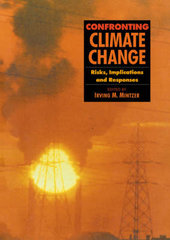
|
Confronting Climate Change: Risks, Implications and Responses
Paperback / softback
Main Details
| Title |
Confronting Climate Change: Risks, Implications and Responses
|
| Authors and Contributors |
Edited by Irving M. Mintzer
|
| Physical Properties |
| Format:Paperback / softback | | Pages:400 | | Dimensions(mm): Height 299,Width 212 |
|
| Category/Genre | Meteorology and climatology
Global warming |
|---|
| ISBN/Barcode |
9780521421096
|
| Classifications | Dewey:551.6 |
|---|
| Audience | | Professional & Vocational | |
|---|
| Illustrations |
25 Tables, unspecified; 2 Halftones, unspecified; 68 Line drawings, unspecified
|
|
Publishing Details |
| Publisher |
Cambridge University Press
|
| Imprint |
Cambridge University Press
|
| Publication Date |
11 June 1992 |
| Publication Country |
United Kingdom
|
Description
Confronting Climate Change is a guide to the risks, dilemmas, and opportunities of the emerging political era, in which the impacts of a global warming could affect all regional, public and even individual decisions. Written by a renowned group of scientists, political analysts and economists, all with direct experience in climate change related deliberations, Confronting Climate Change is a survey of the best available answers to three vital questions: What do we know so far about the foreseeable dangers of climate change? How reliable is our knowledge? What are the most rewarding ways to respond? The book begins by exploring the key linkages and feedbacks that connect the risks of rapid climate change to other important environmental, economic and political problems of our time. Recognizing persistent uncertainties in the scientific understanding of climate change, the book draws attention to those areas of research which may reveal surprises which could change the sense of political urgency surrounding the climate problem - as did the discovery of the Antarctic ozone hole. It explores the geological record of climate change over the Earth's history, seeking a better understanding of how the climate has changed rapidly in countries while minimizing the long-term environmental damages which otherwise will result from continuing the current patterns of energy supply and use. The book is written to cross discipline boundaries, so that policy makers, economists, scientists, risk assessors, environmentalists and development advocates may understand each other's concerns. It shows how the international debate on managing the risks of rapid climate change may be re-shaped for the benfit of people in every nation on the planet.
Reviews'This book is the story of the backstairs arm-twisting, stone walling and finally, in 1992, the signing of the Climate Change Convention at the Earth Summit in Rio de Janeiro. It is a warts-and-all version, written by diplomats, scientists and lobbyists.' Fred Pearce, New Scientist
|